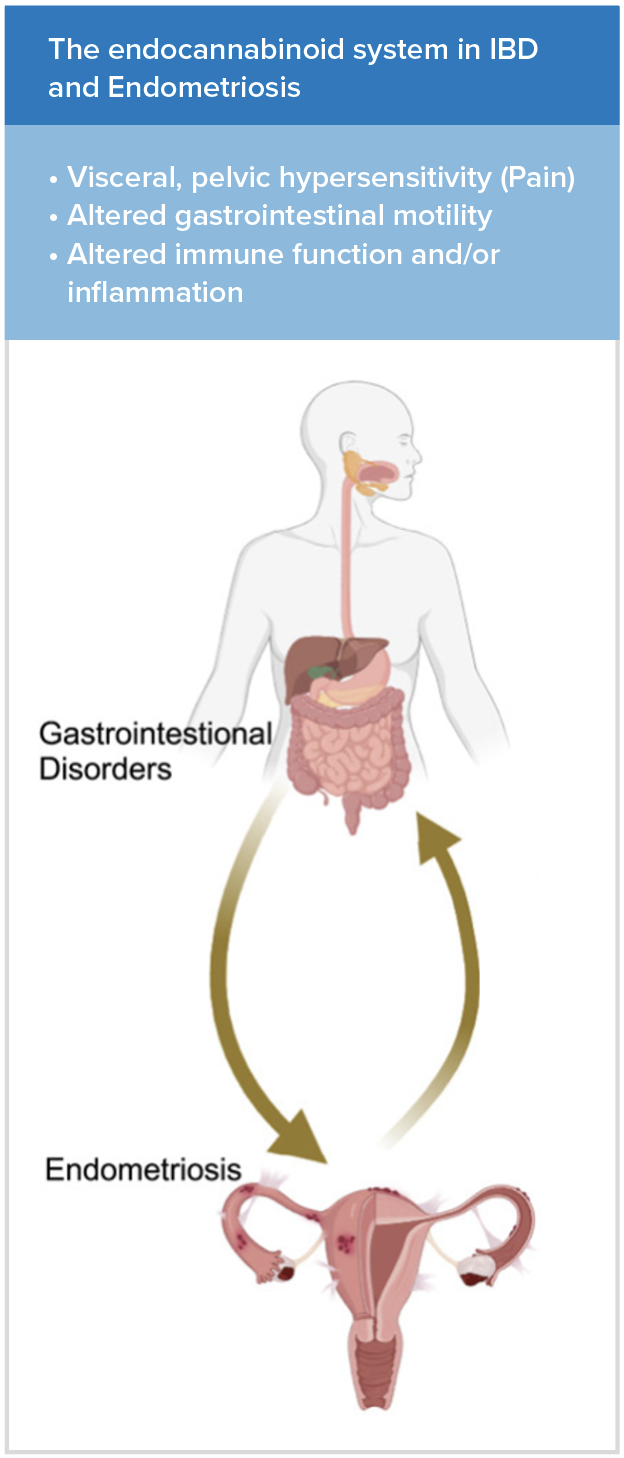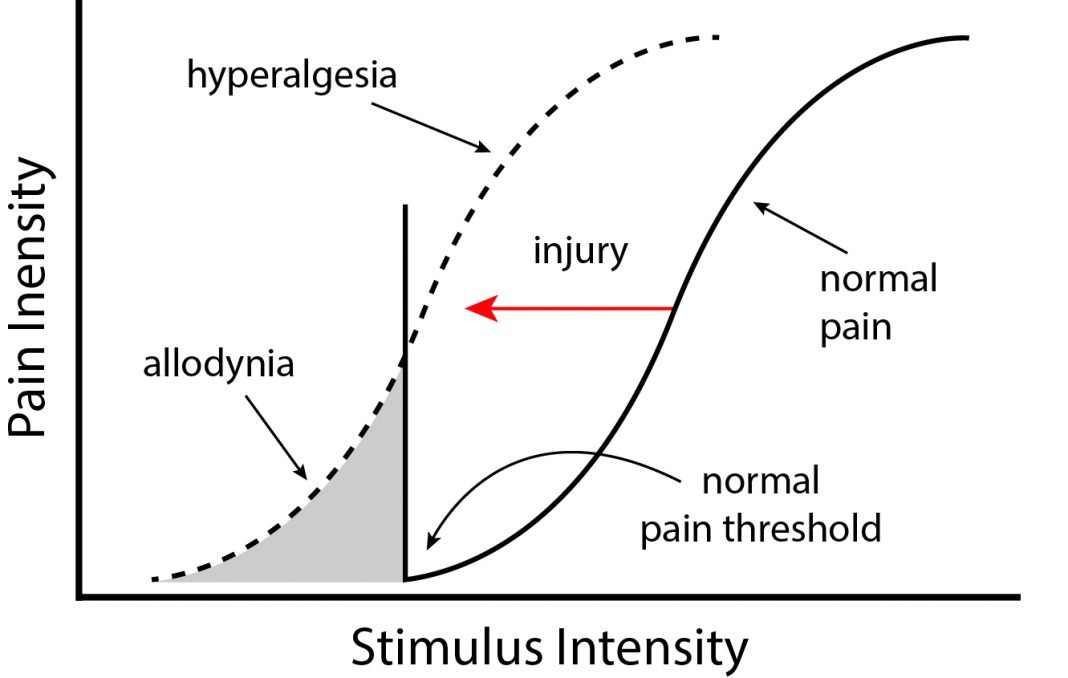Pharma researchers Julie Blaising and Philip Smith from F. Hoffmann-La Roche Ltd. discuss the endocannabinoid system as a pathway to treat inflammatory diseases such as Inflammatory Bowel Disease (IBD) and endometriosis
The endocannabinoid system (ECS) is a complex system that comprises the cannabinoid receptors 1 and 2 (CB1 and CB2, respectively), endocannabinoid (EC) ligands, and enzymes involved in the synthesis and degradation of endocannabinoids. (1) It is broadly expressed in the body and modulates physiology and immunity. (2, 3)
Nociceptor sensitization is a common principle that drives chronic pain
Concept of allodynia: Pain due to a stimulus that does not usually provoke pain.
Concept of hypersensitivity/ hyperalgesia: Conditions that lead to the perception of unusually severe pain in situations that normally cause only moderate pain.
- Nociceptor sensitization typically develops as a consequence of inflammation or tissue damage.
- Sensitized nociceptors have increased signaling in response to noxious stimulation.
- Due to nociceptor sensitization, patients experience pain at lower thresholds.
- In many patients, symptoms persist long after resolution of inflammation and/or tissue healing.

Pain and gastrointestinal dysfunction are symptoms associated with IBD and endometriosis
Persistent pain is a common and debilitating symptom associated with many inflammatory diseases, including IBD, endometriosis (EM), rheumatoid arthritis (RA), and osteoarthritis (OA).
Patients with IBD and endometriosis often exhibit persistent, local pain and develop pain hypersensitivity. This pain is not correlated with ongoing inflammation or disease severity. (4) In addition to pain, patients with IBD and endometriosis commonly experience symptoms of irritable bowel syndrome, such as diarrhea, bloating, and fatigue. These symptoms are also not correlated with the level of inflammation or disease severity (number and/or size of lesions).
Role of the endocannabinoid system in the pathophysiology of chronic pain
The ECS is involved in shared pathophysiology between IBD and endometriosis, such as in pain (hypersensitivity), inflammation, and gastrointestinal disorders (diarrhea, bloating). (5, 6) The cannabinoid receptors 1 and 2 (CB1 and CB2, respectively) are important in the pathophysiology.
- CB1 is mainly involved in pain (hypersensitivity) and diarrhea or constipation. It is highly expressed on enteric neurons in the gut and in somata and fibers in endometriosis lesions.
- CB2 is expressed predominantly on immune cells such as macrophages and mast cells, which mediate the anti-inflammatory effects of endocannabinoids in the GI tract or the peritoneal cavity.
Targeting the endocannabinoid system in IBD and endometriosis
The modulation of the ECS has been shown to produce analgesic and/or anti-inflammatory effects in animal models of IBD, endometriosis, and visceral hypersensitivity. (7) Various pharmacological strategies were used: enhancing endocannabinoid levels by inhibition of endocannabinoid degradation (FAAH, NAAH, MAGL inhibitors,…) or direct activation of CB1 and CB2 (CB1 and/or CB2 agonists). (7)
While symptoms of IBD are thus a high burden to patients and society, there is no targeted therapy available nor, to our knowledge, in development. Standard of care for abdominal pain, the lead symptom, includes paracetamol (acetaminophen) and opioids. The former is not sufficiently effective; the latter is addictive and must not be used chronically (cf. opioid epidemic in the US). Non-steroidal anti-inflammatory drugs (NSAIDs) are seen as controversial in IBD as they may provoke flares. Regarding endometriosis, pain is treated by NSAIDs, and more than 50% of patients with clinically or laparoscopically diagnosed endometriosis take opioids. (8, 9, 10)
Promising treatment for inflammatory diseases
As presented in this article, the ECS is involved in the shared pathophysiology between IBD and endometriosis and could offer a promising therapeutic approach to treating pain and gastrointestinal disorders in these diseases. Peripheral restriction and/or selectivity for specific tissue response is deemed essential to promote beneficial therapeutic responses while avoiding central cannabimimetic side effects.
Despite current preclinical evidence, further characterization of the role of the ECS in patients regarding disease activity, severity, and phenotype is warranted to facilitate the development of novel drugs that target the pathway. Conducting translational research to understand the role of the ECS in the pathogenetic mechanisms of human IBD and endometriosis remains crucial for effectively treating these multifactorial diseases.
References
- Sharkey KA, Wiley JW. The Role of the Endocannabinoid System in the Brain-Gut Axis. Gastroenterology. 2016 Aug;151(2):252-66. doi: https://doi.org/10.1053/j.gastro.2016.04.015. Epub 2016 Apr 29. PMID: 27133395; PMCID: PMC4961581.
- Cani PD, Plovier H, Van Hul M, Geurts L, Delzenne NM, Druart C, Everard A. Endocannabinoids–at the crossroads between the gut microbiota and host metabolism. Nat Rev Endocrinol. 2016 Mar;12(3):133- 43. doi: https://doi.org/10.1038/nrendo.2015.211. Epub 2015 Dec 18. PMID: 26678807.
- Turcotte C, Chouinard F, Lefebvre JS, Flamand N. Regulation of inflammation by cannabinoids, the endocannabinoids 2-arachidonoyl-glycerol and arachidonoyl-ethanolamide, and their metabolites. J Leukoc Biol. 2015 Jun;97(6):1049-70. doi: https://doi.org/10.1189/jlb.3RU0115-021R. Epub 2015 Apr 15. PMID: 25877930.
- DiVasta AD, Zimmerman LA, Vitonis AF, Fadayomi AB, Missmer SA. Overlap Between Irritable Bowel Syndrome Diagnosis and Endometriosis in Adolescents. Clin Gastroenterol Hepatol. 2021 Mar;19(3):528-537.e1. doi: https://doi.org/10.1016/j.cgh.2020.03.014. Epub 2020 Mar 14. PMID: 32184183.
- Lingegowda H, Williams BJ, Spiess KG, Sisnett DJ, Lomax AE, Koti M, Tayade C. Role of the endocannabinoid system in the pathophysiology of endometriosis and therapeutic implications. J Cannabis Res. 2022 Oct 7;4(1):54. doi: https://doi.org/10.1186/s42238-022-00163-8. PMID: 36207747; PMCID: PMC9540712.
- Hasenoehrl C, Taschler U, Storr M, Schicho R. The gastrointestinal tract – a central organ of cannabinoid signaling in health and disease. Neurogastroenterol Motil. 2016 Dec;28(12):1765-1780. doi: https://doi.org/10.1111/nmo.12931. Epub 2016 Aug 26. PMID: 27561826; PMCID: PMC5130148.
- Maccarrone M, Di Marzo V, Gertsch J, Grether U, Howlett AC, Hua T, Makriyannis A, Piomelli D, Ueda N, van der Stelt M. Goods and Bads of the Endocannabinoid System as a Therapeutic Target: Lessons Learned after 30 Years. Pharmacol Rev. (2023). Sep;75(5):885-958. doi: 10.1124/ pharmrev.122.000600. Epub 2023 May 10. Erratum in: Pharmacol Rev. 2023 Dec 15;76(1):194. PMID: 37164640; PMCID: PMC10441647.
- Soliman AM, Surrey E, Bonafede M, Nelson JK, Castelli-Haley J. Real-World Evaluation of Direct and Indirect Economic Burden Among Endometriosis Patients in the United States. Adv Ther. 2018 Mar;35(3):408-423. doi: https://doi.org/10.1007/s12325-018-0667-3. Epub 2018 Feb 15. PMID: 29450864; PMCID: PMC5859693.
- As-Sanie S, Soliman AM, Evans K, Erpelding N, Lanier RK, Katz NP. Short-acting and Long-acting Opioids Utilization among Women Diagnosed with Endometriosis in the United States: A Population-based Claims Study. J Minim Invasive Gynecol. 2021 Feb;28(2):297-306.e2. doi: https://doi.org/10.1016/j.jmig.2020.05.029. Epub 2020 Jun 9. PMID: 32531340.
- Weaver J, Chakladar S, Mirchandani K, Liu Z. Surgical and Pharmacological Treatment Patterns in Women with Endometriosis: A Descriptive Analysis of Insurance Claims. J Womens Health (Larchmt). 2022 Jul;31(7):1003-1011. doi: https://doi.org/10.1089/jwh.2021.0060. Epub 2021 Nov 26. PMID: 34846930.

This work is licensed under Creative Commons Attribution-NonCommercial-NoDerivatives 4.0 International.


